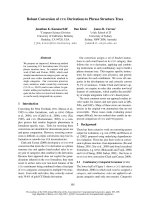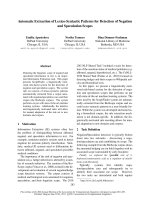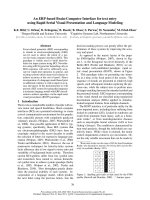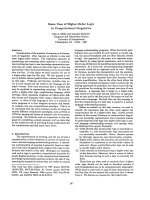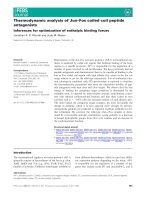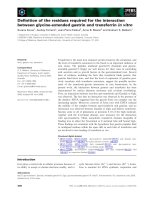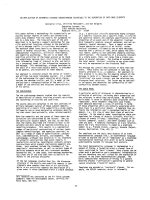Báo cáo khoa học: "An Extension of Earley''''s Algorithm for S-Attributed Grammars" pdf
Bạn đang xem bản rút gọn của tài liệu. Xem và tải ngay bản đầy đủ của tài liệu tại đây (393.36 KB, 4 trang )
An Extension of Earley's Algorithm for
S-Attributed Grammars
Nelson Correa
Department of Electrical Engineering
Universidad de los Andes
Apartado A6reo 4976, Bogotti, D.E., Colombia
bitnet
: NCORREA at ANDESCOL
Abstract
Attribute grammars are an elegant formalization of the
augmented context-free grammars characteristic of most
current natural language systems. This paper presents
an extension of Earley's algorithm to Knuth's attribute
grammars, considering the case of S-attributed
grammars. For this case, we study the conditions on
the underlying base grammar under which the extended
algorithm may be guaranteed to terminate.
Finite
partitioning
of attribute domains is proposed to
guarantee the termination of the algorithm, without the
need for any restrictions on the context-free base.
1. Introduction
Earley's (1970) algorithm is a general algorithm for
context-free languages, widely used in natural language
processing (King, 1983; Shieber, 1985) and syntactic
pattern recognition (Fu, 1982), where the full generative
power of context-free grammar is required. The original
algorithm and its common implementations, however,
assume the atomic symbols of context-free grammars,
thus limiting its applicability to systems with attributed
symbols, or
attribute grammars
(Knuth, 1968).
Attribute grammar is an elegant formalization of the
augmented context-free grammars characteristic of most
current NLP systems. It is more general than members
of the family of unification-based grammar formalisms
(Kay, 1985; Shieber, 1986), mainly in that it allows
and encourages the use of simpler attribution functions
than unification for the definition of attribute values,
and hence can lead to
computationally efficient
grammatical definitions, while maintaining the
advantages of a well-understood declarative formalism.
Attribute grammar has been used in the past by the
author to define computational models of Chomsky's
Government-binding theory, from which practical
parsing programs were developed (Correa, 1987a).
Many systems based on Earley's algorithm have a clear
division between the phases of syntactic and semantic
analysis. Yellin (1988), for instance, uses a syntactic
analysis phase in which Earley's algorithm builds a
factored parse tree (FPT) for the given input, which is
then followed by up to two phases of semantic analysis,
during which the FPT is attributed and evaluated. Watt
(1980) and Jones and Madsen (1980) propose a close
interaction between syntactic and semantic analysis in
the form of "attribute-directed" parsing. However, their
particular realization of the technique is severely
restricted for NLP applications, since it uses a
deterministic one-path (LR) algorithm, applicable only
to semantically unambiguous grammars.
Pereira and Warren (1983) and Shieber (1985) present
v6rsions of Earley's algorithm for unification grammars,
in which unification is the sole operation responsible
for attribute evaluation. However, given the high
computational cost of unification, important differences
between attribute and unification grammars in their
respective attribution domains and functions (Correa,
forthcoming), and the more general nature of attribute
grammars in this regard, it is of interest to investigate
the extension of Earley's algorithm directly to the main
subclasses of attribute grammar.
The paper is organized as follows: Section 2 presents
pieliminary elements, including a definition of attribute
grammar and Earley's algorithm. Section 3 presents the
extension of the algorithm for S-attributed grammars.
In Section 4, we consider the conditions on the
underlying grammar under which the extended algorithm
may be guaranteed to terminate for each input. For the
S-attributed case we show that the algorithm terminates
if the grammar has no cycles or, equivalently, if it is
finitely ambiguous. However,
finite partitioning
of
attribute domains may be used to guarantee the
termination of the algorithm, without the need for
restrictions on the context-free base. Finally, a
conclusion and note on implementation are given.
2. Notation and Preliminaries
We follow the usual notation and terminology for
grammars and languages. A
language
is a set of strings
o~,er a finite set T of symbols. A
grammar
is a formal
device for specifying which strings are in the set. In
particular, a
context-free grammar
is a cuadruple
- 299 -
(N, T, P, S), where N is a finite set of string
categories; T a finite set of terminal symbols; P a finite
set of productions or rewriting rules of the form X ~t~,
Xe N, ae (NUT)*; and S a distinguished symbol of N.
A binary relation ~ of derivation between strings over
the vocalulary NuT of the grammar is defined such that
aXl~ ~ ctol3 iff Xo o is a production of P; now, ~*
may be defined as the reflexive and transitive closure of
~. The language generated by the grammar, noted
L(G), is the set of strings toe T*, such that S ~* to.
An attribute grammar is defined upon a context-free
grammar G=(N, T, P, S), by associating each symbol
Xe NuT with a finite set A(X) of attributes, and a type
or domain dom(a) for each attribute a thus defined
(Knuth, 1968). Each attribute a of X, noted X.a, takes
values over its domain and represents a specific,
possibly context-sensitive property of the symbol.
Attribute values are defined by attribution rules of the
form Xi.a~f(Xj.b Xk.c), associated with each
production p=Xo-~Xt Xn in the grammar, 0<i,j,k<n.
Here, f is an applicative expression (function) whose
value depends on the values of attribute occurrences
associated with symbols in the production. Each time p
applies in a derivation, the attribution rule defines the
value of the attribute occurrence X.a as a function of
the occurrences Xj.b Xk.c, associated with other
symbols in p . We let R(p) denote the packet of
attribution rules associated with p. The grammar may
also define attribute conditions of the form
B(Xi.a Xk.b ), 0 < i, k < n, where B is a Boolean
predicate on the values of attribute ocurrences in p.
This condition must be satisfied in any derivation
requiring the application of p, and thus contributes to
the notion of grammaticality in the language generated
by the grammar. We let B(p) denote the packet of
attribute conditions associated with p.
The above remarks are summarized as follows: An
attribute grmmnar is a cuadruple AG=(G,A,R,B), where
i. G = (N, T, P, S) is a context-free grammar;
ii. A = L3Xe NuT A(X) is a finite set of attributes;
iii. R= k Jpe pR(p) is a finite set of attribution rules,
as above; and
iv. B=L3pe p B(p) is a finite set of attribute conditions,
as above.
The base grammar G assigns a derivation tree x to each
sentence in L(G). The tree is annotated at each node
labelled X with the set A(X) of attributes associated
with X; each attribute ae A(X) defines an attribute
occurrence X.a at node X. If the grammar is well
defined (Knuth, 1968), it is possible to evaluate each
attribute
occurrenc~
on the tree, and we say that • is
correctly attributed iff all attribute conditions yield
'true.' The language generated by the attribute
grammar, L(AG), is now the subset of L(G) whose
members have at least one correctly attributed tree.
It is possible to classify the attributes in AG according
to the manner in which their values are defined. We say
an attribute X.a is synthesized if its value depends only
on attributes of daughters of X; it is inherited if its
value depends on attributes associated with the parent or
sisters of X. We say the grammar is S-attributed if it
contains only synthesized attributes. A more general
and practically important class of L-attributed grammars
is obtained if we allow attributes of both kinds, but
such that each inherited attribute depends only on
inherited attributes of the parent, or attributes of the
sisters to its left (Bochmann, 1976).
Earley's algorithm is a recognizer for CFGs which uses
top-down prediction in combination with bottom-up
parsing actions. Given an input string Xl Xn it
builds a state set Si at each position i of the string,
0< i < n+l. Each state in Si is of the form
<A ~a.l~, f, ~5>, where A ~a.~ is a dotted-production,f
an index to the position in the input string where this
instance of the production began to be recognized (0 < f
< i), and 8 a string of k symbols of Iookahead (k >0).
To begin, all state sets are initialized to empty and the
initial state <¢~.S _1_, 0, _l_k> is put into SO; here
_1_ is the end-of-input marker. States are processed in
order according to the position of their "dot" following
three actions, Predictor, Completer, and Scanner, while
maintaining the following invariant:
State < A ~a-13, f, ~5> is in Si iff the following
derivations are valid:
S ~* GA~ ; a ~* x xf; and ot ~* Xf+l xi.
Since the number of possible states is finite the
algorithm terminates. The input string is accepted if
Sn+I={<~ ~S _1_., 0, .l_k>}. The correctness of this
acceptance condition is a consequence of the invariant.
3. Extension to S-attributed Grammars
The chief element of the extension of the algorithm is a
change in the representation of the states in Earley's
original algorithm to attributed representations. Now,
each dotted production A~a*l~ in a state consists of
symbols attributed according to the grammar. For each
category symbol A in the base grammar, we define the
attributed symbol A[A.al A.an], where A is the
category and A.ai, l<i<n, an attribute occurrence of A.
The extended algorithm, in addition to syntactically
recognizing the input string, evaluates the attribution
associated with each of its possible derivations. In
particular, for each derivation of the attributed final state
- 300 -
<¢ >S[ S.al S.an] _1_., 0, ±k>, where S is the start
symbol of the grammar and S.al S.a n the attribute
occurrences of S associated with that state, the
algorithm evaluates the corresponding attribute
occurrences. For an S-attributed grammar, this is
achieved by the following modification of Earley's
algorithm, in its Completer step:
SO := { < ¢ )'SIS.al S.anl±, O,
£k>
};
for i:= 1 rondo
begin
For each state s in Si, repeat until no more
states may be added to Si or Si+l
begin
1. Predictor
If s = < A >~-X[I, f, 8>
(i.e., s is not final and X non-terminal)
Si
:= Si
t ) { <x ~,o, i, B> I
X >c in P and It in FIRSTk(~8)}
2. Completer
If s = < A-)a., f, 8> (i,e., s is final)
and 8 = Xi+l Xi+k
a. Ae := eval s(A, ct, A->a)
b. Si := Si w { < X >aAe.13, k, It>l
<X >a.AI3, k, It> in Sf }
3. Scanner
If s = < A >a.Xi+ll3, f, 8>
(i.e., s not final and Xi+l the next input symbol)
Si+l := Si+l t ) { < X >aXi+l.~, f, 8> }
end;
If Si+l is empty, reject and terminate
end;
If <¢~S[S.al S.an]_l_., 0, ±k> in Sn+l, accept.
Extension of Earley's Algorithm for
S-attributed Grammars
The states in the algorithm are attributed as indicated
above. For example, the symbol A in the state
<A gao, f, 8> input to the Completer could be shown
more explicitly as A=A[A.al A.an]. As the state
enters the completer, the attribute occurrences A.ai of A
are unevaluated; however, since the grammar is
S-attributed it is easy to show that the attribute
occurrences on the right-hand side a of the production
have already been evaluated. Hence, evaluation of the
attribute occurrences of A reduces to application of the
attribution associated with the production A->a,
according to the attribute values in a. This is done by
the function
eval_s(A, ct, A ~ot),
which returns the
attributed symbol Ae, identical to A, except that its
attribute occurrences have been evaluated, as required.
The last state set generated by the algorithm contains
final states of the form <¢ >S[ ] .1_., 0, -l-k>, in
which the attributed start symbol S[ ] is already
evaluated. Here the extended algorithm differs form
Earley's; whereas the original algorithm generates at
most one final state, regardless of the ambiguity of the
underlying grammar, the extended algorithm may
generate several instances of this state, if the grammar is
ambiguous. Each instance of the final state corresponds
to a different derivation of the initial symbol, leading to
a different evaluation of the symbors attributes.
4. Finite Partitioning of Attribute Domains
The last remark in the extension of section 3 shows a
defect of the Extended Algorithm: It may not terminate
in the general case. For the S-attributed case, however,
this may happen only if the underlying grammar is
~nfinitely ambiguous or, equivalently, if it has
cycles
Or derivations of the form A~+A, for some A~ N.
Consider, for example, the following grammar, which
,measures" the length of each derivation of the sole
string 'a' it generates:
S cA S.v < A.v
A ~A A0.ve A 1.v +1
A >a A.ve- 1
Given the input string 'a', the algorithm defines three
attributted slate sets:
SO = {<¢~ >.S[v]_L, 0, _l_k>, <S[v] >-A[ v], 0, .l_k>,
<A[v] >.a, 0, £k>, <A[ v] >.A[v], 0, d-k> }
S 1
= {<A >a., 0, ±k>,
<S[v] ~A[ 1]., 0, £k>, <A[v] >A[1 ]., 0, _l_k>.
<~->S[ 1]-±, O, ±k>
<S[v] >A.[2], 0, j k>, <A[vl >A[2]-, 0, j.k>,
ad infinitum }
$2 =
{<¢ >S[ I]_L., 0, _Lk>,
<¢ >S[2].L-, 0, ±k>,
ad infinitum
}
Since
S1 is infinite,
the
algorithm
does
not terminate.
Cyclic grammars play an important role in most recent
linguistic theories, including Government-binding (GB),
LexicaI-Functional Grammar (LFG) and GPSG (cf.
Bcrwick, 1988; Con'ca, 1987b; Kornai and Pullum,
1990). These have in common that they have shifted
from rule-based descriptions of language, to declarative
orprinciple-based descriptions, in which the role of
phrase structure rules or principles is relatively minor.
Thus, to make the extension of the algorithm useful for
natural language applications it becomes necessary to
ensure its termination, in spite of cyclic bases.
- 301 -
The termination of the Extended Algorithm may be
guaranteed while maintaining its full generality, through
a finite partition
on the attribute domains associated
with each cyclic symbol in the grammar. For each such
domain
dom (a),
the partition defines a finite collection
of equivalence classes on attribute values. Now, before
adding a new state <A ~a'l~, f, ~i> to a state set Si, we
test for
equivalence
(according to the defined partitions)
rather than equality to some previously added state; if
the new state is equivalent to some other, it is not
added. It is easy to show that the number of attributed
dotted items in the grammar, and hence the size of the
state sets, is now finite. This number is in fact
identical to that of Earley's algorithm, except for a
constant multiplicative factor, dependent on the
grammar and the size of the partitions selected for
attribute domains. Since the size of the state sets
possible with finite partitioning is now finite, the
algorithm always terminates.
After establishing a correspondence between attribute
and unification grammar (UG), we may see that the
technique of "restriction" used by Shieber (1985) in his
extended algorithm is related to finite partitioning on
attribute domains, in fact a particular case which takes
advantage of the more structured attribute domains of
UG. For attribute grammar, given that the domains
involved are more general (e.g., the integers), finite
partitioning is the required device.
5.
Conclusions and
Implementalion Status
This paper presented and extension of Earley's algorithm
to S-attributed grammars. Combining on-line semantic
evaluation with the execution of syntactic actions, the
algorithm is an effective realization of attribute-directed
parsing, as proposed by Watt (1980) and Jones and
Madsen (1980). Although the algorithm is a recognizer,
it computes the semantic values associated with each
derivation of the input string, and hence need not be
extended to compute tree representations. In attribute
grammars with conditions on productions, the values of
attributes already evaluated unay be used to guide the
parsing process, reducing the number of states! that may
be generated by the algorithm.
The extension of the algorithm has been written in "C",
using an efficient "C" implementation of Earley's
original algorithm (Chamorro and Correa, 1990), and is
currently being tested on small grammars. The extended
algorithm will be the kernel of ANDES-l, a
programming environment for attribute grammars,
intended for natural language applications.
References
Berwick, Robert. 1988. "Principlerbased Parsing". MIT
A.I. Memo 972, revised. MIT, Cambridge, MA.
Bochmann, Gregor. 1976. "Semantic Evaluation from
Left to Right."
Communications of the ACM
, Vol.
19, No. 2, p. 55-62.
Chamorro, Miriam, and N. Correa. 1990. "An Efficient
'C' Implementation of Earley's Algorithm" - in Spanish.
CIFI, Universidad de los Andes, Bogot,5, Colombia.
Correa, Nelson. 1987a. "An Attribute Grammar
Implementation of Government-binding Theory."
Proceedings of the 25th Annual Meeting of the ACL,
Stanford University, Stanford, CA.
Correa, Nelson. 1987b. "Empty Categories, Chain
Binding, and Parsing." Parsing Seminar;
MIT Working
Papers of the Lexicon Project,
MIT, Cambridge, MA.
Correa, Nelson. Forthcoming. Attribute and
Unification Grammar: A Review of Formalisms and
Comparision. CIFI, Universidad de los Andes.
Earley, Jay. 1970. "An Efficient Context-free Parsing
Algorithm."
Communications of the ACM
, VoL 13,
No. 2, p. 94-102.
Fu, K.S. 1982.
Syntactic Pattern Recognition.
Academic Press, New York.
Jones, Neii D., and M. Madsen. 1980. "Attribute
Influenced LR Parsing." In N. D. Jones, ed.,
Semantics-directed Compiler Generation
, LNCS 94.
Springer-Verlag, New York.
Kay, Martin. 1985. Parsing in Functional Unification
Grammar. In D. Dowty, L. Karttunen, and A. Zwicky,
eds., Natural Language Parsing,
Cambridge University
Press, Cambridge, England.
King, Margaret, ed. 1983.
Natural Language Parsing.
Academic Press, New York. :
Knuth, Donald. 1968. "Semantics of Context-free
Languages." Mathematical Systems Theory, Vol. 2,
No. 2, p. 127-145.
Kornai, Andras, and G. Puilum, 1990. "The X-bar
Theory of Phrase Structure." Language, Vol. 66.
Pereira, Fernando, and D. H. Warren. 1983. "Parsing
as Deduction."
Proceedings of the 21st Annual Meeting
of the ACL ,
MIT, Cambridge, MA.
Shieber, Stuart. 1985. "Using Restriction to Extend
Parsing Algorithms for Complex-Feature-Based
Formalisms."
Proceedings of the 23rd Annual Meeting
of the ACL,
University of Chicago, Chicago, IL.
Shieber, Stuart. 1986.
An Introduction to Unification
Based Approaches to Grammar.
CSLI Lecture Notes
No. 4, Stanford, CA.
Watt, David. 1980. "Rule Splitting and Attribute
Directed Parsing." In N.D.Jones, ed.,
Semantics-directed
Compiler Generation,
LNCS 94. Springer-Verlag, NY.
Yellin, Daniel. 1988. "Generalized Attributed Parsing."
Manuscript; IBM Research, Yorktown Heights, NY.
- 302 -


